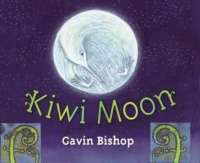
Created by well-known children’s writer and illustrator Gavin Bishop, this is the story of a little white kiwi. When he is born his mother doesn’t recognise him because he’s not brown. Little Kiwi looks to the moon as his mother instead because it is white and bright and round. In the background of this story we see the changing times of a nearby pa. Through illustrations only we see intertribal warfare, the death of the chief, English soldiers arriving and then the burning of the pa. This fire spreads and the two stories become one as the white kiwi’s habitat is razed to the ground.On the surface this is a very simple story but it also contains themes of intertribal warfare, European colonisation of New Zealand, Maori/Pakeha relations, and conservation. There is a lot to savour on each page – with Gavin’s stunning illustrations of the main kiwi story, the on-going images of the pa, plus close-ups of insects and plants.
- ISBN: 9781869416744
- Published: 2005 , Random House New Zealand
- Themes: Animals, colonization, Conservation Of Natural Resources, identities, Maori, Moon, War
- Descriptors: New Zealand, Picture Book, Primary (ages 6-9)
- No. of pages: 48

In Kiwi Moon, we once again see the powerful fascination people have with the moon. We saw the moon personified as a woman in Poemas a la luna (De Conno, 2009) and as a man in Joyce’s (2011) The Man in the Moon; “the light of the moon” is referenced in song and also in Kiwi Moon, yet the moon reflects the sun’s light “busy following the sun” in Mertens (1996) Ginkgo and Moon; in nursery tales, we see the cow jumping over the moon; in Bruchac’s and London’s Thirteen Moons on Turtle’s Back (1992), we see each new moon identified, such as Moon of Popping Trees, Baby Bear Moon, Maple Sugar Moon; we know tales of the moon made of cheese or butter (Griffith, 2012, Moonlight); and we have read stories about the rabbit in the moon in Johnston’s (1998) The Tale of Rabbit and Coyote and with Kiwi Moon, we see the national symbol of New Zealand in an allegorical tale.
In looking at picture books where the moon is featured, the connection is often made through a folktale. These tales might be porquois tales, creation myths, tall tales, trickster tales, or in the case of Kiwi Moon— allegorical tales. Bishop creates a tale utilizing a newly hatched kiwi, full of wonder and innocence to teach readers about the uniqueness of each individual, yet how that very uniqueness might be exploited by others. As young kiwi realizes he looks more like the bright, white, round moon than his mother and siblings, he wonders if this moon might really be his mother.
Typically, folktales reveal aspects of morality, social customs, and history of a people and this is exactly what Bishop does with Kiwi Moon. Within the illustrations of Kiwi’s quest to discover who he is and why he is different, we also see another story emerging, the history of New Zealand’s colonization by the British.
As you read folktales, I encourage you to note the role of the moon. Is the moon male or female? Does the moon give off a brilliant, white light or does it reflect the sun? Are the characters influenced by the moon? In what other ways is the moon symbolized?